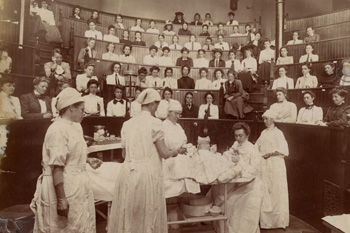History
In our third decade as Drexel University College of Medicine, we continue to celebrate its heritage as a college of opportunity, tracing our roots from two forebear institutions: Hahnemann Medical College and the Woman’s Medical College of Pennsylvania. The College of Medicine proudly upholds enduring values: commitment to educational opportunity, excellence in basic science and clinical preparation, dedicated mentorship and upholding the innovative spirit of visionary institutions.
Hahnemann was established as the Homeopathic Medical College of Pennsylvania in 1848, to provide standardized training in the emerging system of medicine called homeopathy, linked to a foundation in orthodox medical science and practice. It was renamed Hahnemann Medical College in honor of Samuel Hahnemann, the founder of homeopathic medicine. The school welcomed students of all backgrounds. By the late 1920s, the homeopathic focus was gone, but the attention to excellent student preparation lived on. Hahnemann became a nationally known academic medical center and a leading provider of subspecialty care, particularly for cardiovascular disease.
The Woman's Medical College, the first degree-granting medical school in the world for women, was founded in 1850 as the Female Medical College of Pennsylvania. Providing educational opportunity to a diverse cohort of women was its hallmark. Woman's Med trained physicians who practiced all over the globe, creating a corps of impressive female clinicians and scientists to serve as faculty and leaders in medicine. After 120 years, the school became co-educational in 1970 under the name Medical College of Pennsylvania, or MCP. MCP won renown for educational innovation and research, including in women's health, and continued to advance the standing of women scientists and physicians. Learn more about the Legacy Center Archives & Special Collections.

Our legacy schools were brought together by Allegheny Health, Education and Research Foundation, based in Pittsburgh. The two medical colleges were combined and in 1996 took the new name Allegheny University of the Health Sciences. When Tenet Healthcare Corporation acquired the hospitals in 1998, a nonprofit — MCP Hahnemann University — was created to take over the merged medical schools.
Drexel University, itself an historic institution, assumed management of this new academic entity. The medical school became Drexel University College of Medicine in 2002.
Like MCP and Hahnemann, Drexel University had its roots in the provision of opportunity. Financier Anthony J. Drexel founded the Drexel Institute of Art, Science and Industry in 1891 to offer practical education to men and women without regard to socioeconomic status, race or religion. The institute evolved into a university known for excellence in engineering and technology and for its cooperative education program — one of the first of its kind and among the most highly regarded in the nation. With the addition of schools of medicine, nursing and public health, Drexel entered the ranks of the top 100 research universities in the country.

In the medical school, exponential growth in the doctoral, master's and professional programs led to the creation in 2013 of the Graduate School of Biomedical Sciences and Professional Studies within the College of Medicine.
In 2019, Hahnemann University Hospital was closed due to the bankruptcy of its owner, American Academic Health System (AAHS). In the wake of the closure, Drexel University and the College of Medicine developed plans for the continued training of our medical students at other affiliated hospitals. St. Christopher’s Hospital for Children was sold as part of the same AAHS bankruptcy. Drexel and Tower Health stepped in as co-owners of this storied pediatric hospital to continue its service to the families of northeast Philadelphia and beyond.
The collaboration between Drexel and Tower Health also took the form of an academic affiliation agreement, which resulted in a four-year regional medical campus, the College of Medicine at Tower Health, in West Reading, Pennsylvania. The four-year regional medical campus opened in 2021.
In summer 2023, the College of Medicine welcomed first- and second-year MD program students at the state-of-the art Health Sciences Building in University City, near Drexel University’s other colleges and schools.
The College of Medicine benefits from and enhances Drexel's place on the national stage with a heritage of innovation, inclusiveness and excellence that goes back more than 175 years.
Contact Information
215.991.8100
University City Campus
Health Sciences Building
60 N. 36th Street
Philadelphia, PA 19104
West Reading Campus
50 Innovation Way
Wyomissing, PA 19610
Center City Campus
245 N. 15th Street
Philadelphia, PA 19102
Queen Lane Campus
2900 W. Queen Lane
Philadelphia, PA 19129
Elkins Park Campus
8360 Old York Road
Elkins Park, PA 19027
Back to Top